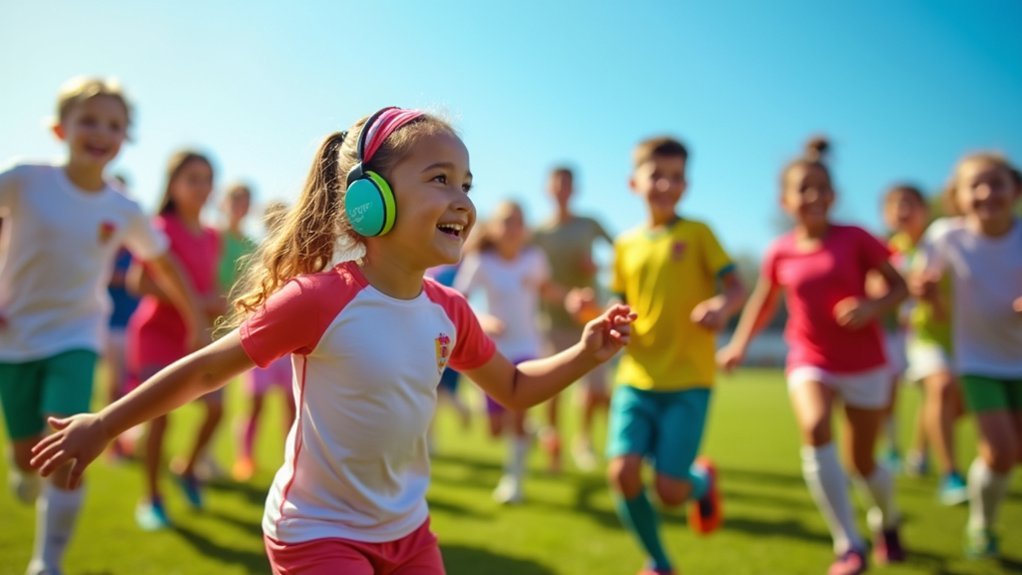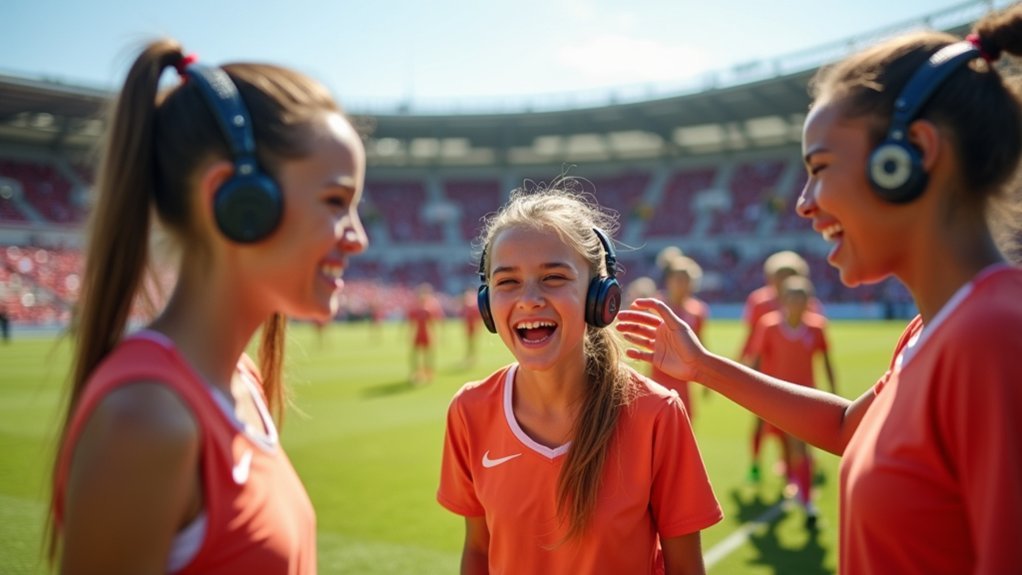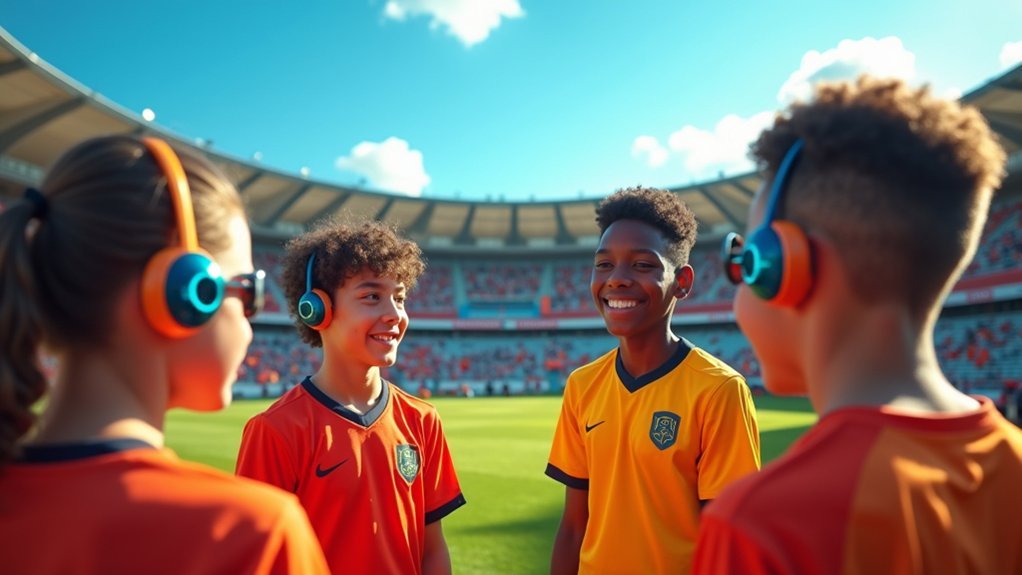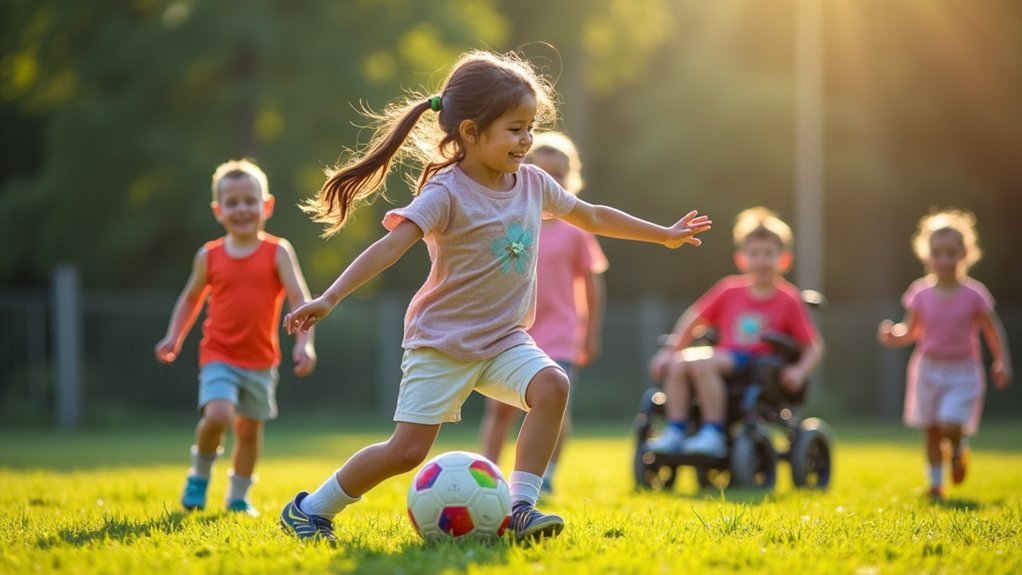Speech devices create inclusive sports experiences by helping athletes communicate regardless of hearing or speech abilities. You’ll find waterproof options for swimming, durable solutions for outdoor activities, and wireless systems that let coaches provide real-time instruction. These technologies boost confidence, improve team dynamics, and allow everyone to fully participate in the social aspects of sports. Discover how the right communication tools can transform athletic experiences for players of all abilities.
Breaking Barriers: How Speech Devices Transform Team Sports

While communication has always been fundamental to team success, speech devices are revolutionizing how athletes and coaches interact on the field. You’ll notice immediate improvements when wireless streamers deliver real-time instructions directly to athletes, cutting through the chaos of background noise.
These tools are game-changers for athletes with hearing impairments, who can now receive clear directions without straining to understand shouted commands. You’re no longer left guessing what your coach wants when the crowd roars.
The benefits extend beyond practical communication—athletes report greater confidence and stronger team cohesion when everyone can participate fully.
Poolside Communication: Waterproof Options for Aquatic Activities
Waterproof accessories like the AquaCase and Aqua Plus technology transform swimming experiences for children with cochlear implants, allowing them to hear clearly even underwater.
You’ll find specialized swim caps and stronger magnets essential for keeping speech devices secure during vigorous water activities.
Mini Microphones enable direct communication between swim coaches and young athletes, creating a seamless learning environment where instructions can be streamed directly to hearing devices despite the challenging pool acoustics.
Waterproof Accessories Guide
For individuals who rely on speech devices, participating in aquatic activities once presented significant challenges.
Today’s waterproof AAC solutions have transformed these experiences, allowing full participation while maintaining communication abilities.
You’ll find several reliable options to choose from. Advanced Bionics’ AquaCase offers complete protection for cochlear implants during swimming and water sports.
Similarly, Cochlear’s Aqua Plus provides a secure fit for various models, guaranteeing you can hear instructions during swimming lessons.
Consider using the Mini Microphone to stream sound directly to your device, cutting through noisy pool environments.
For additional security, stronger magnets or specialized swimming caps can keep your cochlear implant firmly in place during active water movement.
These accessories guarantee that users of all ages can enjoy aquatic activities without sacrificing their ability to communicate effectively.
Swim Coach Connection
Effective communication between swim coaches and students using speech devices transforms the pool into an accessible learning environment.
You’ll find that waterproof accessories like the AquaCase for Naída implants and Aqua Plus for Nucleus models enable your child to participate fully in swim lessons without removing their cochlear implants.
The Mini Microphone is particularly valuable for developing communication skills, as it streams the instructor’s voice directly to your child’s device, cutting through the challenging acoustics of indoor pools.
When selecting equipment for aquatic activities, consider Advanced Bionics’ underwater communication solutions that make lessons more engaging.
For extra security during active swimming, stronger magnets or a well-fitted swimming cap can keep devices firmly in place, ensuring your child never misses important instructions from their coach.
On-Field Success: Selecting the Right Device for Outdoor Sports

When choosing a speech device for outdoor sports, you’ll need weather-resistant options like Phonak’s ComPilot or Advanced Bionics’ AquaCase that can withstand various environmental conditions.
Your selection should prioritize coach communication capabilities, such as streamers with clip-on microphones that transmit instructions directly to your hearing aids during fast-paced activities.
These specialized technologies guarantee you won’t miss vital feedback while focusing on your performance, even in challenging outdoor settings where visual contact isn’t always possible.
Weather-Resistant Solutions
Athletes who rely on speech and hearing devices face unique challenges in outdoor sports, where unpredictable weather conditions can threaten both communication and equipment functionality.
When selecting augmentative and alternative communication tools for the field, prioritize devices with high IP ratings that can withstand moisture and humidity.
For cochlear implant users, specialized accessories like the AquaCase or Aqua Plus provide excellent weather-resistant solutions while maintaining sound quality during activities.
You’ll also benefit from hearing aids with water-repellent coatings and sweat resistance for maximum durability during intense games.
Consider the Mini Microphone from Cochlear for clear communication in outdoor environments—it streams audio directly to your implant despite background noise and distance.
These weather-proofing options guarantee you’ll stay connected regardless of rain, humidity, or challenging conditions on the soccer or baseball field.
Coach Communication Options
Clear communication between coaches and athletes remains essential for success in outdoor sports, especially for participants with hearing or speech challenges. When choosing coach communication options, you’ll need to select technology that’s compatible with your existing hearing devices.
| Device Type | Best For | Key Benefits |
|---|---|---|
| FM Systems | Outdoor fields | Reduces background noise considerably |
| Streamers (ComPilot, Streamer Pro) | Team sports | Wireless connection to hearing aids |
| Mini Microphone | Cochlear implant users | Direct voice streaming in noisy settings |
Research confirms these tools boost athlete confidence and performance by ensuring you receive timely feedback. Your coach’s instructions can be transmitted directly to your hearing device, improving focus during practice and competition. Consider your specific hearing technology when selecting the appropriate communication solution.
Coaching Connections: Enhancing Athlete-Coach Communication
Throughout high-performance sports environments, the ability to communicate effectively stands as a cornerstone of athletic success. When you’re coaching athletes with hearing challenges, speech devices reveal powerful communication functions that bridge critical gaps.
Radio aids and wireless streamers create direct audio connections between you and your athletes, filtering out distracting background noise that often plagues busy training facilities. You’ll notice immediate improvements as athletes focus more on performance rather than straining to understand instructions.
Clip-on microphones and streamers let you deliver real-time feedback and safety guidance without requiring visual contact—essential during dynamic activities like cycling or fencing. This technology empowers athletes to participate fully while boosting their confidence and performance.
Game Day Strategies: Preparing Speech Devices for Sporting Events

When preparing for intense sporting competitions, you’ll need to guarantee your speech devices are fully optimized for the unique challenges of game day environments. Charge your equipment completely and test functionality before leaving home.
| Preparation Task | Why It Matters |
|---|---|
| Pre-program sport vocabulary | Enables quick communication about game action |
| Practice core words | Builds confidence for high-pressure moments |
| Pack portable communication boards | Provides backup if technology fails |
| Connect wireless streamers | Enhances audio clarity in noisy stadiums |
Familiarize yourself with sport-specific terms, including player names and game rules. Use practice sessions to build fluency with core words relevant to the event. Remember to bring portable communication charts customized for the specific sport as a reliable backup option.
Beyond Words: Using Visual Supports in Sports Settings
Visual supports serve as powerful tools that extend communication beyond traditional speech devices in sports environments.
You’ll find that communication boards and pictorial cues markedly enhance understanding for athletes facing verbal challenges, allowing them to participate more fully in team activities.
Implementing visual schedules helps your athletes anticipate upcoming activities, building confidence and improving engagement during practices and competitions.
By incorporating symbols representing specific sports terminology, you’re enabling clearer communication of strategies and plays among teammates.
These visual supports reduce dependence on verbal instructions, particularly valuable in noisy game environments where spoken words may be difficult to process.
Research confirms that athletes using visual supports interact more effectively with coaches and teammates, creating a more inclusive sports experience for everyone regardless of communication abilities.
The Social Advantage: Building Friendships Through Sports Communication
You’ll find that sports communication devices create natural team bonding opportunities as they allow all athletes to share in strategy discussions and celebratory moments regardless of hearing ability.
When coaches implement peer inclusion strategies, such as pairing players for drills who use different communication methods, they foster meaningful connections beyond the playing field.
These intentional social interactions during sports activities help children develop friendships based on shared experiences rather than focusing on communication differences.
Team Bonding Opportunities
How often do we consider the profound social impact that sports participation can have for individuals who use speech devices?
Team bonding opportunities emerge naturally when players share victories, challenges, and growth together on the field. With communication boards and other AAC devices, every team member can actively participate in:
- Pre-game strategy sessions where everyone contributes ideas
- Post-game celebrations that include all voices and perspectives
- Team-building exercises that strengthen connections beyond the game
You’ll find that organized sports create structured environments where relationships develop organically through shared goals.
When coaches incorporate inclusive communication practices, they’re not just building better athletes—they’re fostering a community where everyone belongs. The camaraderie developed through these experiences often extends beyond practice hours, creating meaningful social connections that might otherwise be difficult to establish.
Peer Inclusion Strategies
While mastering physical skills often dominates athletic focus, the social benefits of sports participation can be equally transformative for children who use speech devices. When you implement strategic inclusion techniques, you’ll create powerful friendship opportunities.
| Inclusion Strategy | Friendship Benefit |
|---|---|
| Use core words on communication boards | Enables all athletes to express thoughts clearly |
| Coach modeling of AAC devices | Normalizes alternative communication methods |
| Structured team activities with AAC | Builds collaborative problem-solving skills |
| Peer support partners | Creates natural friendship bridges |
| Communication-focused warm-ups | Establishes routine social interactions |
Research confirms that children using AAC in sports develop stronger social networks. You’ll notice increased self-confidence as teammates learn to communicate effectively together. When coaches actively promote inclusive communication practices, the entire team benefits from improved dynamics and deeper connections that often extend beyond practice time.
Independent Play: Speech Devices for Solo Sports Activities
When athletes engage in solo sports activities, speech devices serve as valuable technological companions that enhance independence and performance. You’ll find customizable vocabulary options that let you program sport-specific terms for quick access during independent play.
These devices transform your solo training sessions by:
Transform your independent training with intelligent voice technology that guides, measures, and elevates every solo workout.
- Providing verbal cues and reminders to maintain proper technique
- Connecting via Bluetooth to sensors that deliver real-time audio feedback
- Integrating with smartphone apps to track performance metrics hands-free
Your speech-generating device empowers you to communicate needs and set personal goals without assistance.
Whether you’re cycling, running, or practicing basketball shots, you’re in control of your experience. This technology creates a feedback loop that mimics coaching while preserving the independence that makes solo sports appealing.
Mounting Solutions: Securing Devices During Active Movement
Securing your speech device properly during sports activities creates the foundation for successful communication on the move. You’ll find various mounting solutions that won’t interfere with your athletic performance while keeping your device protected.
| Mounting Type | Benefits | Best For |
|---|---|---|
| Adhesive Mounts | Strong hold, minimal bulk | Indoor sports |
| Specialized Straps | Adjustable, secure fit | Team activities |
| Waterproof Cases | Moisture protection | Swimming, water sports |
| Lightweight Brackets | Unobtrusive, comfortable | Running, athletics |
| Custom Harnesses | Personalized positioning | Contact sports |
Choose mounting solutions that match your specific sport’s demands. Adjustable systems allow you to position your device effectively for communication access without compromising movement. The best mounts use sweat-resistant materials and remain stable during intense activity, letting you focus on your game rather than worrying about equipment stability.
Success Stories: Athletes Thriving With Communication Technology
Throughout sporting arenas worldwide, athletes with speech and hearing differences are breaking barriers thanks to innovative communication technology.
You’ll find remarkable stories of enhanced performance as these technologies create inclusive sporting environments.
Athletes report significant improvements when using communication technology:
- Increased confidence and focus during competitions
- Enhanced safety in sports like cycling and fencing through clear auditory instructions
- Better instructor feedback in noisy environments via direct sound transmission
Swimmers with cochlear implants can now hear instructions underwater using waterproof accessories.
Parents and coaches consistently note that these technologies not only improve performance but foster independence.
Whether it’s Phonak’s ComPilot or Oticon’s Streamer Pro, these devices are transforming athletic experiences, allowing you to concentrate on your sport rather than straining to hear instructions.
Frequently Asked Questions
Can Insurance Cover Sports-Specific Speech Devices?
Yes, your insurance may cover sports-specific speech devices if deemed medically necessary. Check with your provider about coverage requirements and obtain a speech pathologist’s prescription to strengthen your claim for approval.
How Do Temperature Extremes Affect Device Performance?
Extreme heat can drain your device’s battery faster, while cold may slow response time. You’ll notice reduced performance in both conditions. Protect your device with insulated cases when using it outdoors.
What Maintenance Schedule Keeps Devices Reliable During Seasons?
You’ll keep devices reliable by cleaning monthly, checking batteries weekly, testing sound quality quarterly, updating software seasonally, and storing in climate-controlled areas during off-seasons. Don’t forget annual professional inspections for peak performance year-round.
Are There Devices Specifically Designed for Refereeing?
Yes, you’ll find wireless referee communication systems, electronic whistles, and VAR technology specifically designed for officiating. They’re durable, weatherproof, and improve game management through clear communication and instant replays.
How Can Non-Speaking Coaches Effectively Lead Teams?
You can lead teams effectively through nonverbal communication like visual aids, whistles, demonstration, and hand signals. Utilize assistive technology, written game plans, and body language to convey strategies and motivate your athletes.
In Summary
You’ve now seen how speech devices open up a world of athletic possibilities. Whether you’re coaching, competing, or just having fun, these tools break down communication barriers that once limited participation. As technology continues to evolve, you’ll find even more ways to connect on the field, in the pool, or on the court. Don’t wait—jump into sports with confidence and make your voice heard!





Leave a Reply